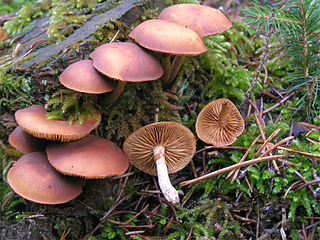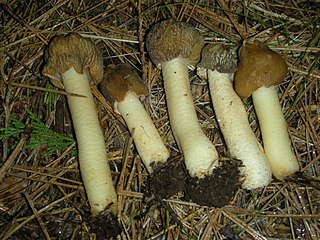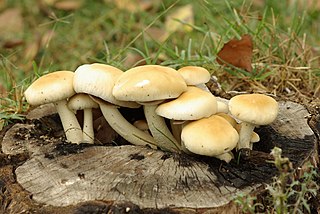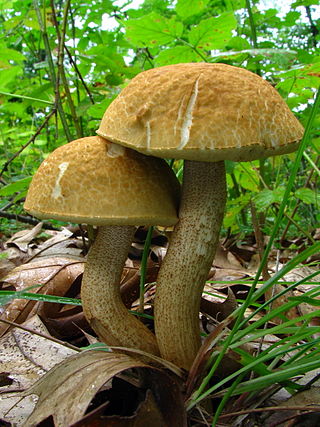
Galerina is a genus of small brown-spore saprobic fungi, with over 300 species found throughout the world from the far north to remote Macquarie Island in the Southern Ocean. The genus is most noted for some extremely poisonous species which are occasionally confused with hallucinogenic species of Psilocybe. Species are typically small and hygrophanous, with a slender and brittle stem. They are often found growing on wood, and when on the ground have a preference for mossy habitats.

Agrocybe is a genus of mushrooms in the family Strophariaceae. The genus has a widespread distribution, and contains about 100 species.

Clitocybe dealbata, also known as the ivory funnel, is a small white funnel-shaped basidiomycete fungus widely found in lawns, meadows and other grassy areas in Europe and North America. Also known as the sweating mushroom, or sweat producing clitocybe, it derives these names from the symptoms of poisoning. It contains potentially deadly levels of muscarine.

Leratiomyces ceres, commonly known as the chip cherry or redlead roundhead, is mushroom which has a bright red to orange cap and dark purple-brown spore deposit. It is usually found growing gregariously on wood chips and is one of the most common and most distinctive mushrooms found in that habitat. It is common on wood chips and lawns in North America, Europe, Australia, New Zealand and elsewhere. The name Stropharia aurantiaca has been used extensively but incorrectly for this mushroom.

Clitocybe rivulosa, commonly known as the false champignon or fool's funnel, is a poisonous basidiomycete fungus of the large genus Clitocybe. One of several species similar in appearance, it is a small white funnel-shaped toadstool widely found in lawns, meadows and other grassy areas in Europe and North America. Also known as the sweating mushroom, it derives this name from the symptoms of poisoning. It contains potentially deadly levels of muscarine.

Cortinarius caperatus is an edible mushroom of the genus Cortinarius found in northern regions of Europe and North America. It was known as Rozites caperata for many years before genetic studies revealed that it belonged to the genus Cortinarius. The fruit bodies appear in autumn in coniferous and beech woods as well as heathlands in late summer and autumn. The ochre-coloured cap is up to 10 cm (4 in) across and has a fibrous surface. The clay-colored gills are attached to the stipe under the cap, and the stipe is whitish with a whitish ring. The Latin specific name, caperatus, means wrinkled, and refers to the distinctive texture of the cap. The flesh has a mild smell and flavor.

Verpa conica, commonly known as the bell morel or the early morel, is a species of fungus in the family Morchellaceae. Sometimes mistaken for a true morel, this species is an “early morel” characterized by a cap resembling a thimble that is freely attached to the stem.

Verpa bohemica is a species of fungus in the family Morchellaceae. Commonly known as the early morel or the wrinkled thimble-cap. The mushroom has a pale yellow or brown thimble-shaped cap—2 to 4 cm in diameter by 2 to 5 cm long—that has a surface wrinkled and ribbed with brain-like convolutions. The cap hangs from the top of a lighter-colored, brittle stem that measures up to 12 cm long by 1 to 2.5 cm thick. Microscopically, the mushroom is distinguished by its large spores, typically 60–80 by 15–18 µm, and the presence of only two spores per ascus.

Polyozellus multiplex is a species complex of fungi first described in 1899. P. multiplex is commonly known as the blue chanterelle, the purple chanterelle, or, in Alaska, the black chanterelle. However, this mushroom is not closely related to true chanterelles. While this name used to refer to a group of species, it is now used to describe only one species that held onto the name P. multiplex. The fruiting bodies of this species are blue- to purple-colored clusters of vase- or spoon-shaped caps, with veiny wrinkles on the underside which run down the length of the stem. P. multiplex was considered the monotypic species of the genus Polyozellus until recent molecular research divided the P. multiplex species complex into five species. The genus name is derived from the Greek poly meaning many, and oz, meaning branch. The specific epithet multiplex means "in many pieces," referring to the compound nature of the fruiting body.

Agrocybe pediades, commonly known as the common fieldcap or common agrocybe, is a typically lawn and other types of grassland mushroom, but can also grow on mulch containing horse manure. It was first described as Agaricus pediades by Swedish mycologist Elias Magnus Fries in 1821, and moved to its current genus Agrocybe by Victor Fayod in 1889. A synonym for this mushroom is Agrocybe semiorbicularis, though some guides list these separately. Technically it is edible, but it could be confused with poisonous species, including one of the genus Hebeloma.

Cortinarius infractus, commonly known as the sooty-olive Cortinarius or the bitter webcap, is an inedible basidiomycete mushroom of the genus Cortinarius. The fungus produces sooty-olive fruit bodies with sticky caps measuring up to 13 cm (5.1 in) in diameter. The fruit bodies contains alkaloids that inhibit the enzyme acetylcholinesterase.

Cortinarius vanduzerensis is a species of mushroom in the family Cortinariaceae. Described as new to science in 1972, it is known only from the Pacific Northwest region of North America, where it grows under conifers such as spruce, hemlock, and Douglas-fir. The fruit bodies of the fungus, or mushrooms, have a slimy dark chestnut-brown cap that becomes deeply radially grooved or corrugated in maturity, and reaches diameters of up to 8 cm. The gills on the underside of the cap are initially pinkish-buff before becoming pale brown when the spores mature. The stem is lavender, measuring 10–18 cm (4–7 in) long and 1–2 cm thick. The mushroom produces a rusty-brown spore print, with individual spores measuring 12–14 by 7–8 micrometers. The edibility of the mushroom has not been determined, and it has been described as "much too slippery to be of value".

Agrocybe praecox, commonly known as the spring fieldcap, spring agrocybe or early agrocybe, is a species of brown-spored mushroom which appears early in the year in woods, gardens and fields. According to modern taxonomic analysis, it is just one of a cluster of closely similar species which are often referred to as the Agrocybe praecox complex. It is found in Europe, North Africa and North America.

Agrocybe putaminum, commonly known as the mulch fieldcap, is a species of agaric fungus in the family Strophariaceae in the Agrocybe sororia complex. Described as new to science in 1913, it is found in Asia, Australia, Europe, and western North America, where it grows in parks, gardens, and roadsides in woodchip mulch. Fruitbodies of the fungus have a dull brownish-orange cap with a matte texture, a grooved stipe, and a bitter, mealy taste.

Picipes badius, commonly known as the black-footed polypore or black-leg, is a species of fungus in the family Polyporaceae. It causes a white rot of hardwoods and conifers. The species is found in temperate areas of Asia, Australia, Europe, and North America. It has a dark brown or reddish-brown cap that reaches a diameter of 25 cm (9.8 in), and a stipe that is often completely black or brown at the top and black at the base.

Cyclocybe aegerita, also calledAgrocybe cylindracea, Agrocybe aegerita or Pholiota aegerita, is a mushroom in the genus Cyclocybe which is commonly known as the poplar fieldcap or poplar mushroom, or velvet pioppini. In Japan, it is called Yanagi-matsutake (柳松茸).

Leccinellum rugosiceps, commonly known as the wrinkled Leccinum, is a species of bolete fungus. It is found in Asia, North America, Central America, and South America, where it grows in an ectomycorrhizal association with oak. Fruitbodies have convex, yellowish caps up to 15 cm (5.9 in) in diameter. In age, the cap surface becomes wrinkled, often revealing white cracks. The stipe is up to 10 cm (3.9 in) long and 3 cm (1.2 in) wide, with brown scabers on an underlying yellowish surface. It has firm flesh that stains initially pinkish to reddish and then to grayish or blackish when injured. The pore surface on the cap underside is yellowish. Fruitbodies are edible, although opinions vary as to their desirability.

Agrocybe retigera is a species of mushroom in the genus Agrocybe. The first known sighting of the species was in the early 1950s. It was first described by author Speggazini Singer in 1950. The mushroom has since been found in common areas, especially grassy ones, such as gardens, meadows and parks. Agrocybe retigera is most commonly found in tropical and sub-tropical areas around the globe. The size of the cap is usually between 17 and 44 millimetres, and it is generally pale in colour. The colour of the mushroom itself ranges from cream to pale-brown.

Agrocybe sororia is a species of Basidiomycota mushroom in the genus Agrocybe. The cap is convex to plane, tawny fading to pale yellow-buff; the pileus sometimes is cracked, or wrinkled. The gills have an adnate attachment to the stipe. The spore print is cinnamon-brown. The stem is cylindrical, equal, concolor with the cap and lacks a ring; usually with white cords in the stem base. It is found in wood mulch. Odour and taste mealy. This mushroom distributes in eastern North America.

Cyclocybe parasitica, also known as tawaka in Māori language or poplar mushroom, is a species of gilled mushroom in the genus Cyclocybe found mostly in New Zealand and Australia. It grows on native and introduced trees where it can cause heart rot, and does not seem to be associated with conifers.




















